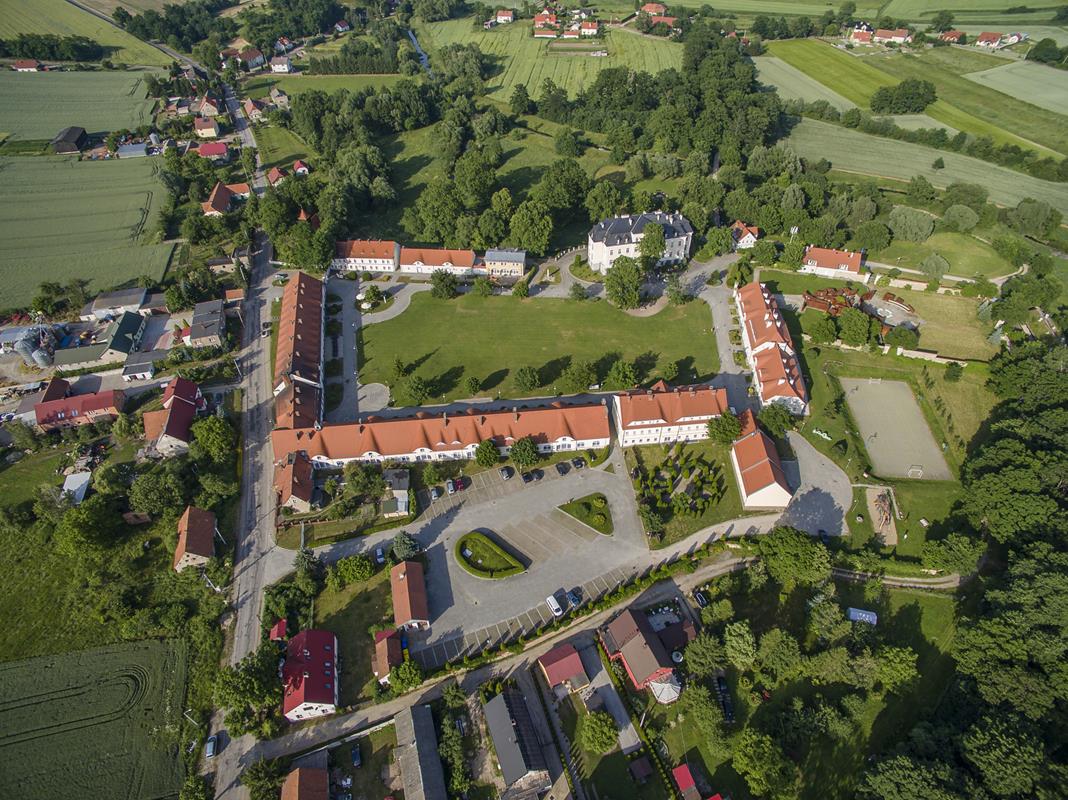
The surroundings of palace in Krzyżowa is characterized by a highly diverse habitat. In the radius of a kilometer a number of habitats, such as farmlands, unmown meadows, a pond with eutrophic waters and overgrown edges, a ditch with a reed bed, a young deciduous forest, an ancient oak avenue, a wild fruit orchard, numerous lone trees and field plantings, home gardens as well as mown lawns, can be found. The mosaic of habitats positively influences the species diversity of plants and animals.
1. Oak avenue and the old lone trees in the palace surroundings
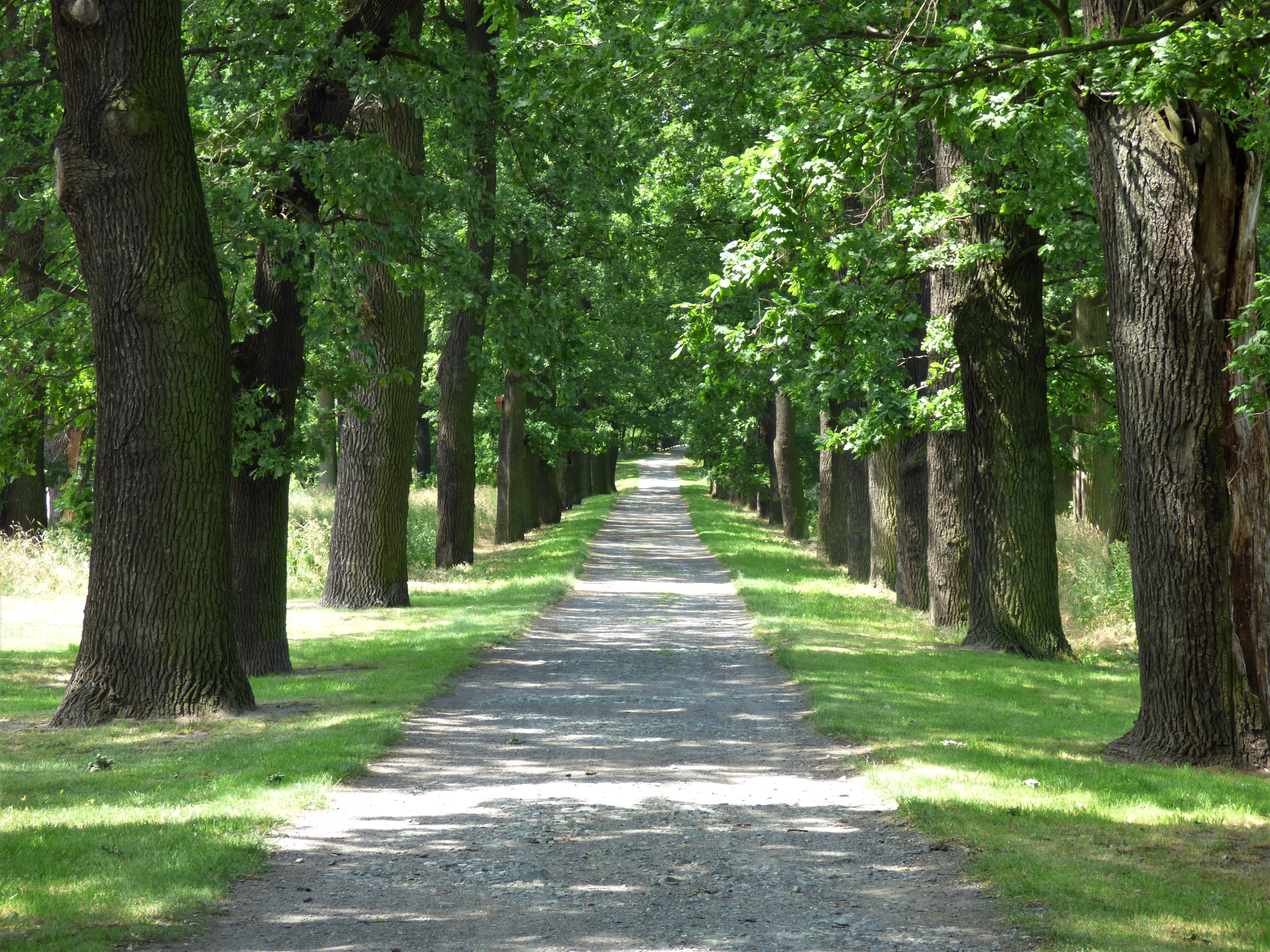
Ancient trees possess much higher natural value as the the young ones. They constitute the habitat of many species of plants, animals and fungi. Their size, shape as well as wounds, hollows and spaces under the roots created during their long lives, form irreplaceable homes for many other organisms.
Tree avenues are ecological corridors, which means that they are safe pathways for the animals to relocate. Many species (big beetles, bats) are not able to migrate over bigger distances in open spaces. Big trees growing closely to each other make it possible for them to move around and colonize new areas.
Photo: Oak avenue in June (by Hanna Sztwiertnia)
The mature trees are less and less numerous, in many towns they are removed due to renovation works by the roads, thus the value of the ones which still exist, should be emphasized. The pedunculate oak avenue (Quercus robur) is therefore one of the most valuable natural elements of the Palace surrounding, despite the anthropogenic origins and mono species composition of the tree stand. The century-old oaks are a potential habitat for rare species of beetles, such as great capricorn beetle (Cerambyx cerdo) or osoderma eremita. However, in the palace avenue it is easier to find protected bird species, such are a big and dashy green woodpecker (Picus viridis), which, against all the appearances, prey mostly not in the trees, but on the ground.
2. The pond and the ditch around the Palace - aquatic habitats
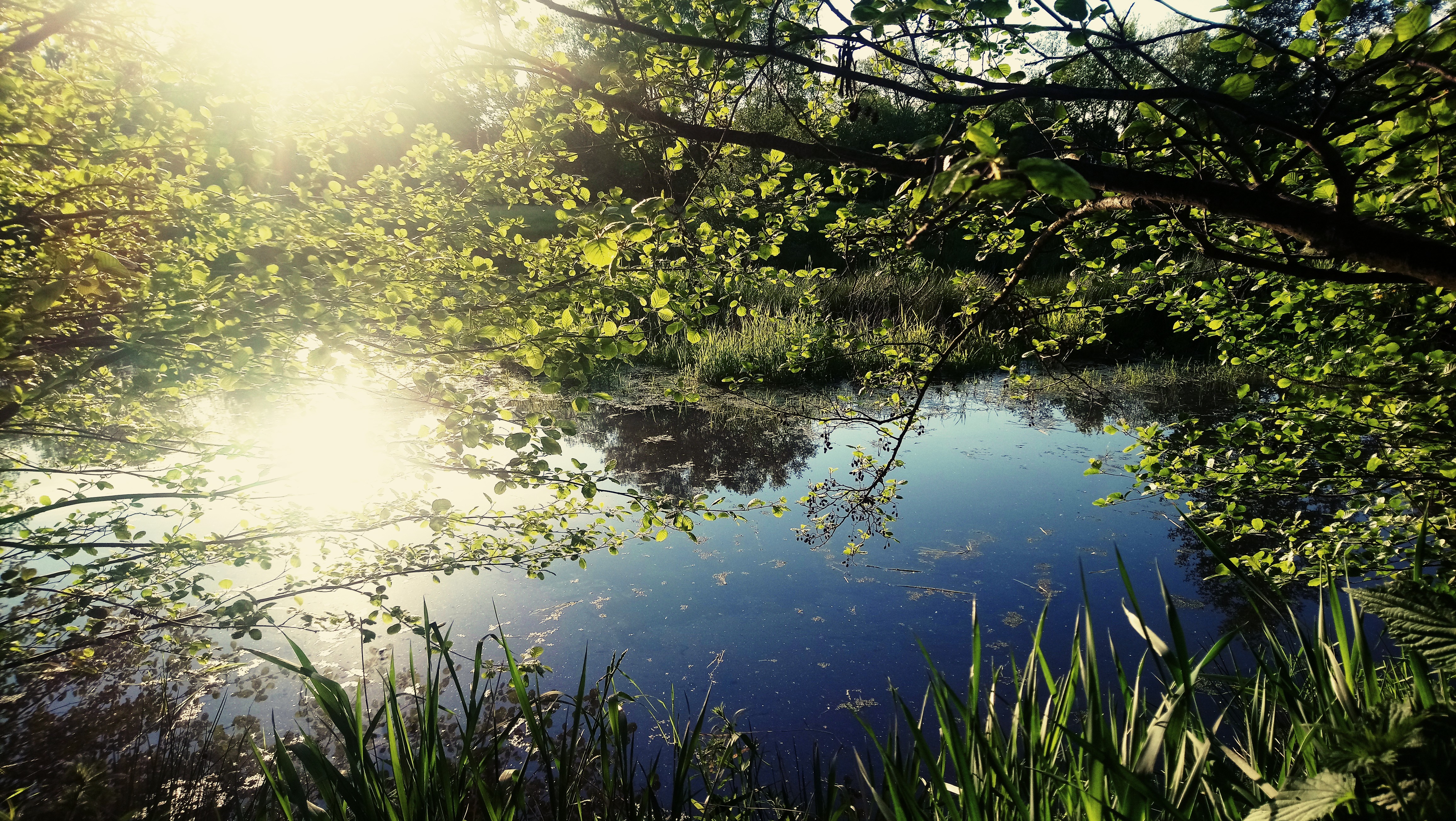
3. Wild orchard by the House on the Hill
Even though the tree stand is mostly composed of cultured species of trees, its natural value is very high. The trees growing here such as apple trees, cherry trees and pear trees have the abundance of hollows and other microhabitats important for the animals. First the flowers and then the fruits produced by them attract birds and insects. Lush meadow growing basally, which has not been mown for a long time, is full of interesting plants which are considered weeds. With all certainty, many edible plants can be found here.
Photo: We are looking for edible wild plants in the orchard (by Małgorzata Pietkiewicz)
4. Cemetery hill
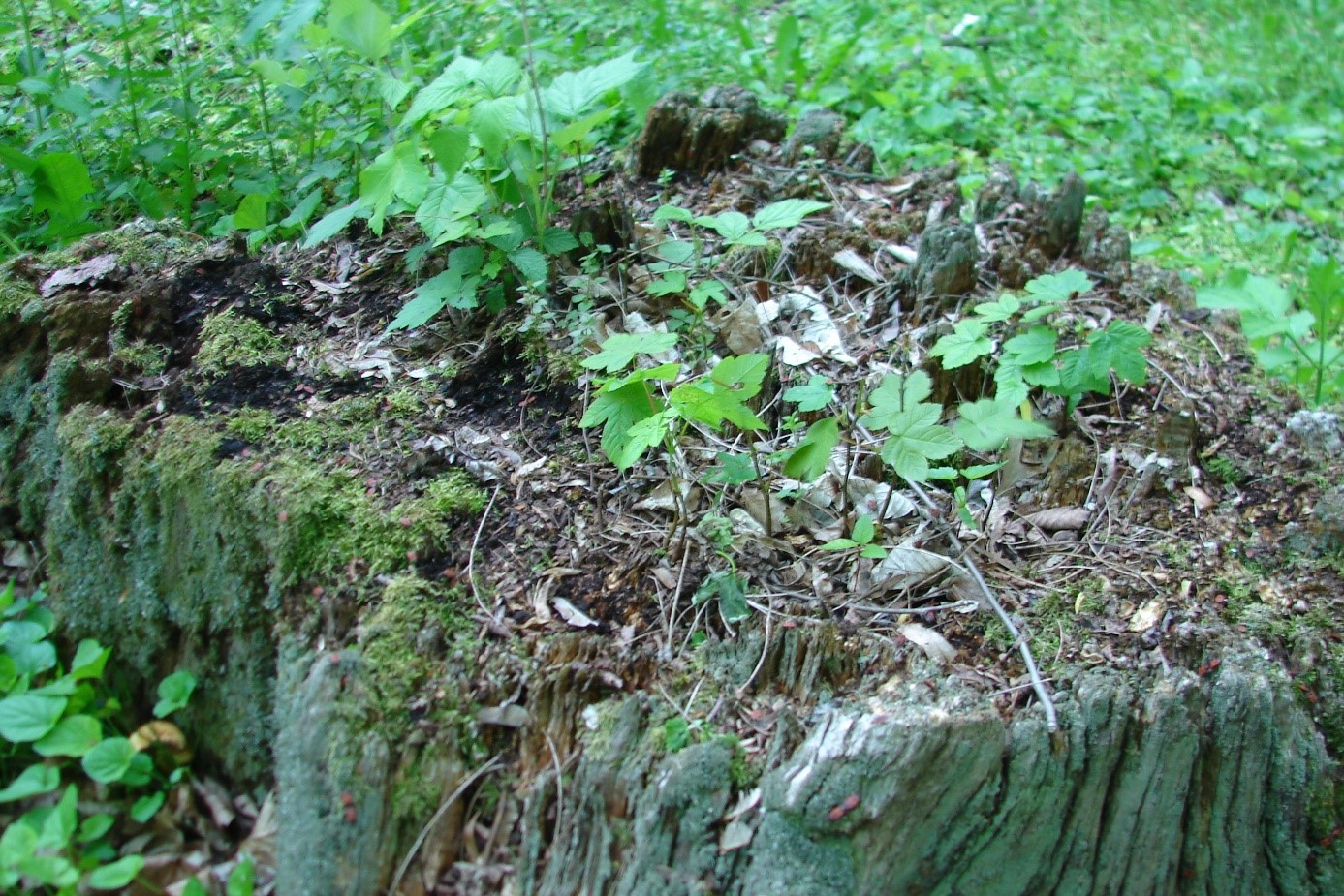 The hill is overgrown by middle-aged deciduous agricultural oak-hornbeam forest. This is one of the most species-wise diverse forest stands - trees including small-leaved linden, tilia platyphyllos, pedunculate oak, European hornbeam, Norway maple, sycamore or beech coexist here. The forest on the Hill, similarly to most of the Polish forests is formed by the forestry. Some species are weakened, some are promoted.
The hill is overgrown by middle-aged deciduous agricultural oak-hornbeam forest. This is one of the most species-wise diverse forest stands - trees including small-leaved linden, tilia platyphyllos, pedunculate oak, European hornbeam, Norway maple, sycamore or beech coexist here. The forest on the Hill, similarly to most of the Polish forests is formed by the forestry. Some species are weakened, some are promoted.
Photo: Dead wood with numerous bryophytes and lichens. (by Zofia Dziuba)
The sign of the introduction of foreign species, perhaps in decorative purposes connected to the graveyard function of this place, are geographically foreign black locust, red oak and chestnut. Due to the young age of the trees, the forest does not represent high natural value - there are not many hollowed trees or decaying downed trunks which have positive impact on biodiversity. Additionally, this forest is strongly penetrated by the locals, there are, among others, “wildly” chartered downhill cycling paths and, unfortunately, numerously left rubbish. In terms of age, the most interesting part of the Hill is the east slope, the area of the former evangelical graveyard, where, among the tombstones, ancient lindens overgrown with protected common ivy survived (Hedera helix). As in any forest, a number of animals and herbaceous plants typical for forest communities will be encountered, making this area attractive in terms of its educational aspects. Among birds the following species can be listed: great titmouse, blue tit, marsh tit, finch, collared flycatcher, long-tailed tit, nuthatch, great spotted woodpecker. Among the herbaceous plants we can encounter so-called geophytes, which are species blooming early in the spring, when the umbrella of the leaves is not yet developed and it allows the sunlight till the bottom of the forest. These are wood anemone, lesser cendaline, gagea, galanthus, snowdrop. Later in the vegetation season, the bottom of the forest becomes poorer in the blooming plants,
While being in the place, where the human remains are worshiped, it is worth to reflect and observe the commonness and the profits of death in the nature. The best evidence if the forest has natural features or if its biodiversity is similar to the backwoods, is the presence of the dead wood, especially old standing dead trees and laying decaying logs. The more dead wood, the more fungi decomposing them, moss using its humidity, arthropods (e.g. insects) and molluscs praying in them. Insects, arachnids, diplodas and snails are then food for bigger animals: amphibians, mammals and birds. Decomposed wood enriches the plant litter, enabling the growth of the following generation of plants. By removing the wood from the forest and cutting trees before them having been weakened by fungi and insects we interrupt the natural cycle. Dead trees are needed in a living forest.
Even though there is not much dead wood at the Cemetery Hill, we can still look for little pieces of branches, twigs and old trunks of look under the dead leaves. We will find there strands of fungi, invertebrate hiding from the drought, lichens and bryophytes.
5. Riverine meadows
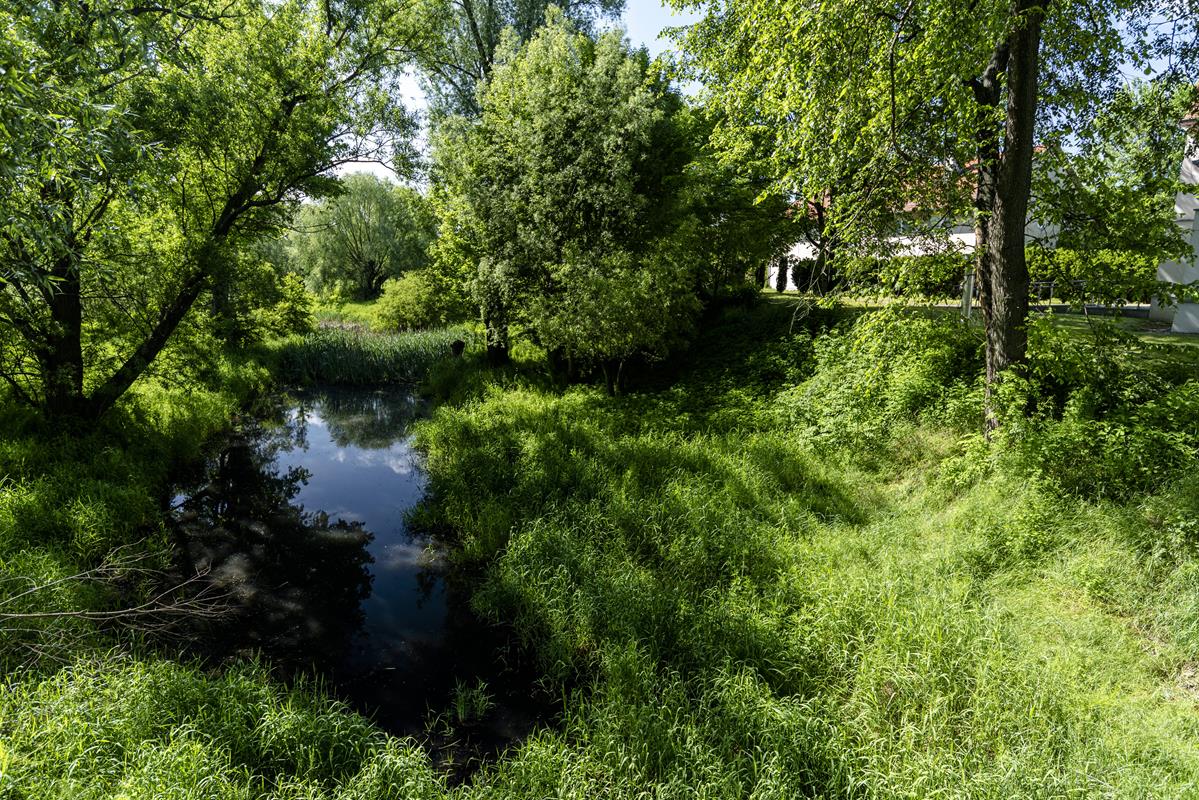
In the landscape of Krzyżowa an important role is played by the Piława River. Currently it is regulated, partly separated from its vavenue by flood embankment, however still influencing adjoining area. The terrain adjoining the river bed, which were not turned into plough fields are the humid meadows. During the flood they are fertilized by the river and during the rains, it is the place with the higher level of groundwater. Majority of them is species-rich. Foxtail dominates among the grasses, but a lot of colourfully blooming species such as cabbage thistle, meadowsweet, mud geranium or garden loosestrife can be found. In the places, where the soil is drier, which means in the bigger distance from the river bed, a bigger part is taken by Arrhenatherum elatius, cocksfoot and among the colourfully blooming plants - meadow cranesbill or leucanthemum vulgare.
6. Invasive plants
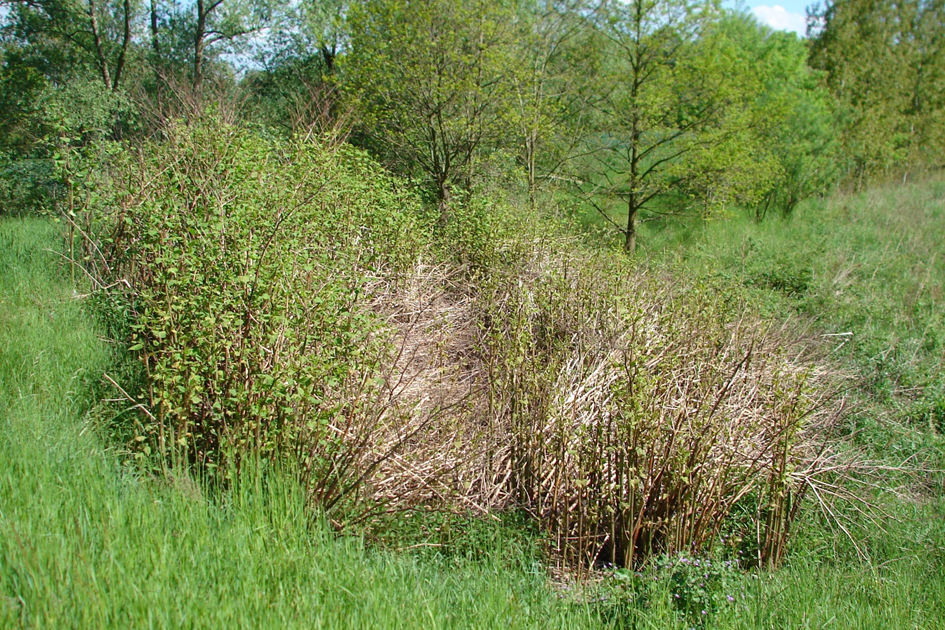 The river is a habitat of plants and water animals, but it is also a mean of transport for seeds and plant parts, thanks to what they can spread quickly along the river’s vavenue. An example of that use of the river is the case of Japanese knotweed (Reynoutria japonica) - an enormous perennial growing by the bridge entering the Oak avenue and along its banks.
The river is a habitat of plants and water animals, but it is also a mean of transport for seeds and plant parts, thanks to what they can spread quickly along the river’s vavenue. An example of that use of the river is the case of Japanese knotweed (Reynoutria japonica) - an enormous perennial growing by the bridge entering the Oak avenue and along its banks.
Photo: A clump of invasive Japanese knotweed by the palace bridge (by Zofia Dziuba)
The species coming from Asia, in Europe it is considered an invasive one. Brought in the decorative purposes, it spread very quickly, endangering local ecosystems - especially the ones of river vavenues. It’s earthbound parts, however thick and very grand, die every year. The winter is survived by rootstalks, which can reach as far as 2 meters deep in the ground. The seeds and detached parts of the rootstocks move along the river and colonize new areas down the river. A dashy clump of the Japanese knotweed can be found nearby the bridge leading from the palace to the Oak avenue.
7. Vines by the Palace
Even though the buildings are not usually associated with lush vegetation, also here we can also reflect over the survival strategies of different plants. By the stairs of the Palace there are representatives of three vine species, representing the continents. Common ivy (Hedera helix) is the representative of 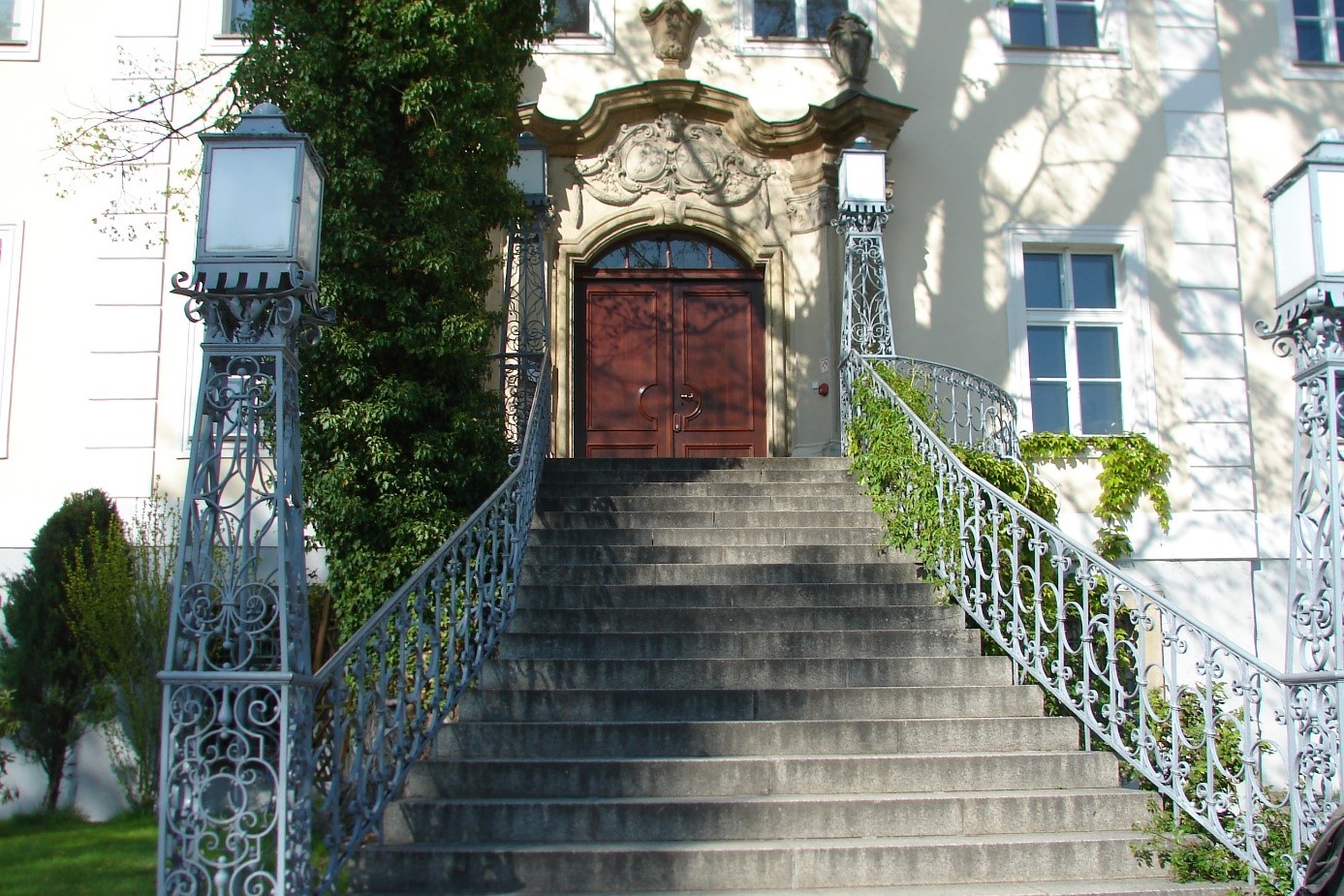 European flora, parthenocissus quinquefolia (Parthenocissus quinquefolia) comes from North America, and parthenocissus tricuspidata from Asia.
European flora, parthenocissus quinquefolia (Parthenocissus quinquefolia) comes from North America, and parthenocissus tricuspidata from Asia.
Photo: On the left: common ivy on the tree trunk, on the right: parthenocissus quinquefolia on the stair bannister, parthenocissus tricuspidata under the window. (by Zofia Dziuba)
What connects them? Vines are the plants originating from diverse systematic families (thus they are not related) and they reach significant height thanks to the long and flexible shoots climbing props. The evolutionary advantage of such a strategy is the avoidance of energetic effort of producing a trunk, whose task is to elevate the leaves to the light as high as possible.
The vines use ready made props - tree trunks, rocks, building. Their young shoots have the ability to grow towards shade, because the possibility to find the props there is the highest (this mechanism is the opposite to the one happening in the leaf petiole, directing the leaves towards the light). The mechanism of the attachment to the prop is different among different species. The ivy produces adventitious roots entering cracks in the bark, concrete or rock and producing a substance uniting the plant with its prop. On the other hand, the parthenocissus quinquefolia and tricuspidata create pulvilli at the end of the shoot, which, in the case of the former one, is also transformed in the clamp. Besides the attachment to the substratum, it also has the ability to wrap, which is well visible at the bannister of the stairs.
Reaching significant height is crucial for the plant mainly due to the access to the light. On the example of the ivy visible by the stairs, we can observe another aspect of the height, which is connected to reproduction. We can see that after reaching a certain height the ivy begins to create stiff shoots projecting from the trunk, with leaves of a different shape. These are flower shoots. Ivy flowers are inconspicuous, but fragrant. Their fragrance has the ability to attract an appropriate number of pollinators only at greater height. Then the created fruits, thanks to the fact of being placed a few meters above the ground and herbal plants, are easy to be noticed by the birds, which are feeding on them and propagating them. Ivy is the species, on the example of which climate change can be observed. Only last year the fruiting specimens were common only in the mild oceanic climate - e.g. in Great Britain. In Poland the blooming specimens were provided protection. Nowadays, the mild winters allow the ivy to bloom at most positions.
Małgorzata Pietkiewicz, Małgorzata Rudy, Hanna Sztwiertnia
The "Green Krzyżowa" tab was created thanks to the funding of the Heinrich Böll Foundation.



